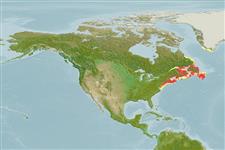Environment: milieu / climate zone / depth range / distribution range
Ecologia
marino; salmastro demersale; distribuzione batimetrica 0 - 73 m (Ref. 57178). Temperate; 62°N - 35°N, 82°W - 3°W (Ref. 57356)
Northwest Atlantic: southern Delaware north to Labrador.
Length at first maturity / Size / Peso / Age
Maturity: Lm 9.0, range 7 - ? cm
Max length : 23.5 cm TL maschio/sesso non determinato; (Ref. 5951)
Short description
Chiavi di identificazione | Morfologia | Morfometria
Spine dorsali (totale) : 0; Raggi dorsali molli (totale) : 52 - 61; Spine anali: 0; Raggi anali molli: 26 - 33; Vertebre: 62 - 70. Number of lateral plicae 106-126, with a mean of 117.4. Best separated from A. dubius by the number of plicae singly or in combination with the number of vertebrae.
Found in shallow coastal waters as well as in protected bays and estuaries (Ref. 10198). Occurs in large schools and burrows in the sand at times to a depth of several inches. Feeds primarily on copepods (Ref. 27549).
Nizinski, M.S., B.B. Collette and B.B. Washington, 1990. Separation of two species of sand lances, Ammodytes americanus and A. dubius, in the western North Atlantic. Fish. Bull. 88:241-255. (Ref. 10198)
IUCN Red List Status (Ref. 130435)
Threat to humans
Harmless
Human uses
Pesca: di potenziale interesse
Strumenti
Special reports
Download XML
Fonti Internet
Estimates based on models
Preferred temperature (Ref.
123201): 2.7 - 14.2, mean 7.9 °C (based on 128 cells).
Phylogenetic diversity index (Ref.
82804): PD
50 = 0.5156 [Uniqueness, from 0.5 = low to 2.0 = high].
Bayesian length-weight: a=0.00204 (0.00128 - 0.00325), b=3.16 (3.03 - 3.29), in cm total length, based on LWR estimates for this species & Genus-body shape (Ref.
93245).
Trophic level (Ref.
69278): 3.2 ±0.0 se; based on diet studies.
Generation time: 4.6 ( na - na) years. Estimated as median ln(3)/K based on 1
growth studies.
Resilienza (Ref.
120179): Medio, tempo minimo di raddoppiamento della popolazione 1.4 - 4.4 anni (Preliminary K or Fecundity.).
Fishing Vulnerability (Ref.
59153): Moderate vulnerability (37 of 100).
Nutrients (Ref.
124155): Calcium = 60.3 [31.5, 129.4] mg/100g; Iron = 0.414 [0.224, 0.729] mg/100g; Protein = 19 [18, 20] %; Omega3 = 0.421 [0.214, 0.762] g/100g; Selenium = 10.4 [4.7, 22.7] μg/100g; VitaminA = 30.5 [10.1, 92.3] μg/100g; Zinc = 0.845 [0.569, 1.247] mg/100g (wet weight);
